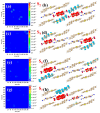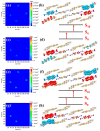Physical Mechanisms of Intermolecular Interactions and Cross-Space Charge Transfer in Two-Photon BDBT-TCNB Co-Crystals
- PMID: 36014621
- PMCID: PMC9414930
- DOI: 10.3390/nano12162757
Physical Mechanisms of Intermolecular Interactions and Cross-Space Charge Transfer in Two-Photon BDBT-TCNB Co-Crystals
Abstract
Co-crystal materials formed by stacking different molecules with weak interactions are a hot research topic. In this work, we theoretically investigate the intermolecular interactions and charge transfer properties of the supramolecular BDBT-TCNB co-crystal (BTC). The π-π bonds, hydrogen bonds, and S-N bonds in the BTC bind the BDBT and TCNB molecules together to form a highly ordered co-crystal and lead to the co-crystal's excellent two-photon absorption (TPA) properties. The intermolecular interactions of the BTC are discussed in detail by the independent gradient model based on Hirshfeld partition (IGMH), atoms in molecules (AIM), electrostatic overlay diagram, and symmetry-adapted perturbation theory (SAPT) energy decomposition; it is found that there is a strong interaction force along the stacking direction. The charge transfer properties of the one-photon absorption (OPA) and TPA of the BTC were investigated by charge density difference (CDD) and transition density matrix (TDM). It is found that the dominant charge transfer mode is the cross-space charge transfer along the stacking direction. Therefore, strong intermolecular interactions will promote intermolecular cross-space charge transfer. This work is of great significance for the design of organic optoelectronic supramolecular materials.
Keywords: BDBT–TCNB co-crystals; cross-space charge transfer; intermolecular interactions; two-photon absorption.
Conflict of interest statement
The authors declare no conflict of interest.
Figures









References
-
- Wang X., Krebs L.J., Al-Nuri M., Pudavar H.E., Ghosal S., Liebow C., Nagy A.A., Schally A.V., Prasad P.N. A chemically labeled cytotoxic agent: Two-photon fluorophore for optical tracking of cellular pathway in chemotherapy. Proc. Natl. Acad. Sci. USA. 1999;96:11081–11084. doi: 10.1073/pnas.96.20.11081. - DOI - PMC - PubMed
-
- Li H., Yang Y., He C., Zeng L., Duan C. Mixed-ligand metal–organic framework for two-photon responsive photocatalytic c–n and c–c coupling reactions. ACS Catal. 2018;9:422–430. doi: 10.1021/acscatal.8b03537. - DOI
LinkOut - more resources
Full Text Sources
Research Materials
Miscellaneous

